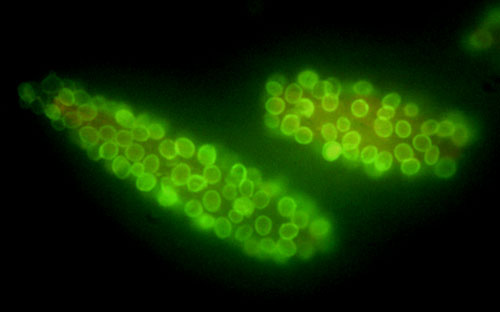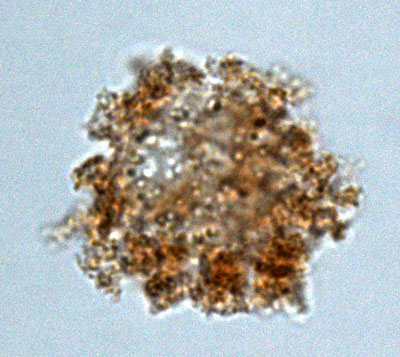| Posted: May 29, 2012 | |
Functionalizing living cells through nanotechnology |
|
| (Nanowerk Spotlight) Modifying living cells by coating them with a nanolayer of functional materials in order to provide them with new structural and functional features has developed into a popular research area for bionanotechnology researchers. In contrast to genetic manipulation techniques, here the functionality of a cell is modified simply by attaching polymers or nanoparticles to the cell's surface. | |
| A Perspective paper in the May 21, 2012 online edition of ACS Nano ("'Face-Lifting' and 'Make-Up' for Microorganisms: Layer-by-Layer Polyelectrolyte Nanocoating") covers the most interesting and promising work in this area and presents an outlook the major potential future directions. | |
| "In our work we have been concentrating on improving the ways of positioning of nanoparticles and nanotubes onto living cells," Rawil F. Fakhrullin, Senior Lecturer, Biomaterials and Nanomaterials Group, Department of Microbiology at Kazan Federal University, tells Nanowerk. "Imagine a system where a large cell is coated with millions of nanoparticles which potentially can penetrate into the cytoplasm and eventually kill the cell. Early research reports were based on the direct, unmediated deposition of nanoparticles onto cells, and sometimes it was required to pre-treat cells in harsh conditions. Obviously, the cells did not survive, and could be used only as sacrificial templates. In contrast, our groups managed to utilize the popular Layer-by-Layer (LbL) technique in combination with cells and as a result, cells were still viable and functional after the treatment." | |
| Fakhrullin has been authoring the ACS Nano Perspective with Yuri M. Lvov, Professor and Tolbert Pipes Eminent Endowed Chair on Micro and Nanosystems at Louisiana Tech University. In it, the two focus on on cell encapsulation with LbL self-assembly via sequential adsorption of oppositely charged components: polyelectrolytes, nanoparticles, and proteins. | |
 |
|
| Artificial 3D multicellular clusters build from nanocoated yeast cells. (Image: Dr. Fakhrullin, Kazan Federal University) | |
| Fakhrullin explains that this LbL method for encapsulation is based on the consecutive deposition of polycations and polyanions, bound together through electrostatic interactions and applied first for planar film production and later for encapsulation of colloids, including biological cells. | |
| He notes that this simple encapsulation technique enables researchers to process many biological cells in parallel. | |
| "The ability to design shells of any composition, containing nanosized layers of polymers, proteins, and nanoparticles in a predetermined order enables control of the capsules' properties, such as sensitivity to temperature and pH, permeability, and structural stability," says Fakhrullin. "These surface-functionalized cells thus have their intrinsic functions enhanced or altered." | |
| Using this fabrication approach, scientists can easily assemble functionalized cells into larger 3-D blocks – like artificial multicellular structures or engineered tissues – or immobilize them onto patterned surfaces. Another direction might be the encapsulation of nutrients in the coatings. Yet another example is the protection of LbL-coated cells from immune system for the cell delivery and therapies. | |
| In their paper, Fakhrullin and Lvov outline the four main research directions in bioencapsulation: | |
| – LbL functionalization of isolated microorganisms (e.g., fungi, algae, and bacteria); | |
| – functionalization of isolated mammalian cells, including human cells; | |
| – encapsulation of cell aggregates, tissue sections, and microorganisms (e.g.,microworms); and | |
| – encapsulation of viruses. | |
| Another important area concerns the LbL functionalization of living cells with nanoparticles. | |
| "Polyelectrolytes facilitate adhesion of nanoparticles to biological cells, thus providing the stability of the sandwich-like polyelectrolyte/nanoparticle coating and suppressing nanoparticle internalization through the cell walls into the cytoplasm," explains Fakhrullin. | |
| During the LbL process, a 20-60 nm thick flexible, hydrogel-like coating is assembled onto a living cell, in effect producing an artificial structure that mimics a cell wall. Toxicological research has shown that the fragile cellular membrane of human cells (less so on more robust microbial cells) can be affected by the deposition of extracellular polymer multilayers. | |
| Scientists hypothesize that the apparent toxicity of polycations can be explained by their electrostatic interaction with the cellular membrane, which causes pore formation and the subsequent cell death. To resolve this issue, LbL assembly with natural biocompatible polyelectrolytes, polysaccharides, poly(amino acids), DNA, and polyphenols aims to improve encapsulated shell viability. | |
| Functionalized cells may find a number of practical applications, including as biosorbents, biosensors , in spore formation, and in tissue engineering. | |
| "The advantage of using polymer-modified cells is the almost unlimited quantity of different combinations (wall architectures) possible," says Fakhrullin. "Functional nanoparticles and nanodevices can be embedded into wall multilayers, which, in turn, may further attenuate the functionality of the composite shell. The modified cells not only act as microtemplates but also exhibit intrinsic functionality, including proliferation." | |
 |
|
| An isolated human cell coated with magnetic nanoparticles (brown hue around the cell; optical microscopy). (Image: Dr. Fakhrullin, Kazan Federal University) | |
| "In my opinion" he continues, "the most important results can be obtained with magnetic cells. For instance, we have recently shown how the direct magnetic functionalization of human cells can be applied to manipulate cells using a simple magnet, thus opening new avenues for cell therapy" (see "A Direct Technique for Magnetic Functionalization of Living Human Cells"). | |
| Fakhrullin thinks that we will see the exponential growth of papers in the area of functional cells. He argues that there are many still unused nanocoatings and even more types of cells. | |
| "We believe, that the major challenge now is to control precisely the time when the coating are still on the living cell, and also to prepare 'smarter' coatings, which would help to control the transport to and from the cells, their communications with other cells, etc." | |
 By
Michael
Berger
– Michael is author of three books by the Royal Society of Chemistry:
Nano-Society: Pushing the Boundaries of Technology,
Nanotechnology: The Future is Tiny, and
Nanoengineering: The Skills and Tools Making Technology Invisible
Copyright ©
Nanowerk LLC
By
Michael
Berger
– Michael is author of three books by the Royal Society of Chemistry:
Nano-Society: Pushing the Boundaries of Technology,
Nanotechnology: The Future is Tiny, and
Nanoengineering: The Skills and Tools Making Technology Invisible
Copyright ©
Nanowerk LLC
|
|
|
Become a Spotlight guest author! Join our large and growing group of guest contributors. Have you just published a scientific paper or have other exciting developments to share with the nanotechnology community? Here is how to publish on nanowerk.com. |
|
